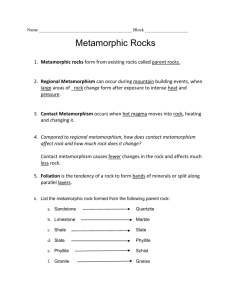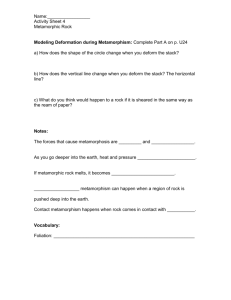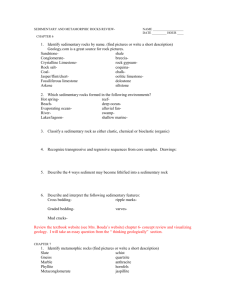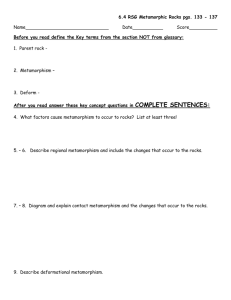Blakeley Jones October 1, 2009 Geology Exam Review Review 4
advertisement
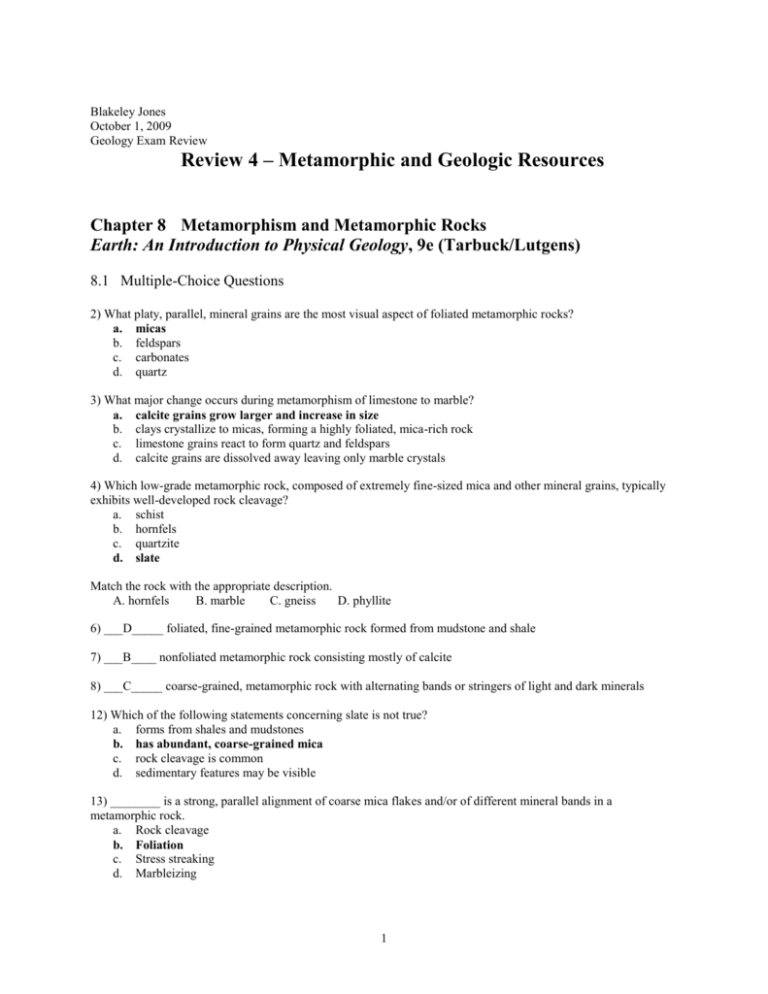
Blakeley Jones October 1, 2009 Geology Exam Review Review 4 – Metamorphic and Geologic Resources Chapter 8 Metamorphism and Metamorphic Rocks Earth: An Introduction to Physical Geology, 9e (Tarbuck/Lutgens) 8.1 Multiple-Choice Questions 2) What platy, parallel, mineral grains are the most visual aspect of foliated metamorphic rocks? a. micas b. feldspars c. carbonates d. quartz 3) What major change occurs during metamorphism of limestone to marble? a. calcite grains grow larger and increase in size b. clays crystallize to micas, forming a highly foliated, mica-rich rock c. limestone grains react to form quartz and feldspars d. calcite grains are dissolved away leaving only marble crystals 4) Which low-grade metamorphic rock, composed of extremely fine-sized mica and other mineral grains, typically exhibits well-developed rock cleavage? a. schist b. hornfels c. quartzite d. slate Match the rock with the appropriate description. A. hornfels B. marble C. gneiss D. phyllite 6) ___D_____ foliated, fine-grained metamorphic rock formed from mudstone and shale 7) ___B____ nonfoliated metamorphic rock consisting mostly of calcite 8) ___C_____ coarse-grained, metamorphic rock with alternating bands or stringers of light and dark minerals 12) Which of the following statements concerning slate is not true? a. forms from shales and mudstones b. has abundant, coarse-grained mica c. rock cleavage is common d. sedimentary features may be visible 13) ________ is a strong, parallel alignment of coarse mica flakes and/or of different mineral bands in a metamorphic rock. a. Rock cleavage b. Foliation c. Stress streaking d. Marbleizing 1 15) Which of the following would exhibit sheared and mechanically fragmented rocks? a. fault movements at shallow depths b. intense compression in a deep-seated, regional metamorphic zone c. heating of shales and mudstones near a pluton d. regional metamorphism of pyroclastic volcanic rocks 16) Which of the following best describes the conditions of contact metamorphism? a. Pressures are very high, the rock is deeply buried, and temperatures are raised by the Earth's internal heat. b. Pressures are fairly low, the rock is in the upper part of the crust, and heat is supplied from a nearby magma body. c. Heat is generated by shearing and mechanical movements along faults. d. Depths are fairly shallow, but temperatures and pressures are so high that the rocks begin to partially melt. 17) ________ forms from the metamorphism of limestone or dolostone. a. Migmatite b. Amphibolite c. Marble d. Quartzite 18) What foliated, metamorphic rock is texturally intermediate between slate and schist? a. fault breccia b. phyllite c. quartzite d. gneiss 19) ________ is characterized by the segregation of light- and dark-colored minerals into thin layers or bands. a. Garnet hornfels b. Granitic gneiss c. Slate d. Quartzite 22) Which of the following lists the rocks in the order of increasing grain size and increasing grade of metamorphism? a. phyllite, slate, schist b. schist, slate, phyllite c. slate, phyllite, schist d. slate, schist, phyllite 23) ________ is typically formed by metamorphism of a sandstone. a. Marble b. Slate c. Amphibolite d. Quartzite 25) What is the major source of heat for contact metamorphism? a. deep burial and heat from the Earth's interior b. heat from grinding and shearing on faults c. heat from the spontaneous decomposition of micas and feldspars d. heat from a nearby magma body 26) In which setting would regional metamorphism be most likely? a. at shallow depths below an oceanic ridge or rift zone b. at shallow depths along major transform faults in the continental crust c. at great depths in the crust where two continents are colliding d. at shallow depths beneath the seafloor where water pressures are immense 2 29) What term describes the zone of contact metamorphism surrounding an intrusive magma body? a. aura b. auricle c. oracle d. aureole 30) During metamorphism, what is the major effect of chemically active fluids? a. increase the pressures in deeply buried, regional-metamorphic zones b. aid in the movement of dissolved silicate constituents and facilitate growth of the mineral grains c. prevent partial melting so solid rocks can undergo very high temperature regional metamorphism d. facilitate the formation of schistosity and gneissic banding in hornfels and slates 31) What two, metamorphic rocks are composed predominantly of single minerals? a. mica schist and granitic gneiss b. fault breccia and graphitic schist c. garnet schist and hornfels d. marble and quartzite 8.3 True/False Questions 2) T or F: Slate and schist are both derived by metamorphism of shales and mudstones. TRUE 4) T or F: Calcite is the main mineral constituent of the sedimentary rock limestone and of the metamorphic rock marble. TRUE 7) T or F: At high pressures and elevated temperatures of regional metamorphism, silicate rocks are more resistant to flowage and deformation than at low temperatures and pressures. FALSE 8) T or F: Foliated metamorphic rocks are composed largely of equidimensional grains of minerals such as quartz and calcite. TRUE 9) T or F: Rock cleavage or slaty cleavage in slates is largely a consequence of abundant, parallel-aligned, very fine-grained mica flakes in the rock. TRUE 10) T or F: Muscovite, biotite, and chlorite are common minerals found in phyllites and schists. TRUE 12) T or F: Quartzites and metaconglomerates are formed along faults by intensive fracturing and fragmentation of conglomerate beds and quartz veins. FALSE 13) T or F: High-grade, regional metamorphism produces significant and recognizable changes in the textures and mineral compositions of rocks. TRUE 15) T or F: Three major factors involved in metamorphism are elevated temperature, elevated pressure, and the chemical action of hot fluids. TRUE 16) T or F: During metamorphism, most rock is composed of solid mineral grains, but small amounts of hot fluids or partial melting may facilitate the metamorphic process. TRUE Chapter 23 Energy and Mineral Resources Earth: An Introduction to Physical Geology, 9e (Tarbuck/Lutgens) 3 23.1 Multiple-Choice Questions 1) ________ coal is typically found only in association with tightly folded strata. a. Anthracite b. Peat c. Lignite d. Bituminous 2) Cap rock and reservoir strata refer to accumulations of ________. a. sedimentary iron ore b. petroleum c. oil shale d. bedded rock salt 5) ________ is a nonrenewable resource. a. Solar power b. Water c. Petroleum d. Timber 8) Ore deposits of ________ form by prolonged, intense, tropical weathering of specific kinds of bedrock. a. silver b. mercury c. aluminum d. magnesium 10) Bauxite is an ore of ________. a. iron b. tin c. gold d. aluminum 16) ________ are used as abrasives. a. Diamond and garnet b. Calcite and gypsum c. Apatite and galena d. Talc and graphite 18) The United States, with about 6 % of the world's population, uses about ________ of the world's total, annual, energy production. a. 9% b. 30% c. 3% d. 15% 19) ________ supplies the largest percentage of energy consumed annually in the United States. a. Petroleum b. Coal c. Hydroelectricity d. Uranium 22) Coal and petroleum are considered to be fossil fuels because ________. a. their energy content was derived from ancient sunlight b. carbon dioxide, released when they burn, contributes to the greenhouse effect c. their oxygen and nitrogen content were derived from the ancient atmosphere d. coal beds and petroleum reservoir rocks contain abundant fossils 4 23) ________ has the largest, current production and reserves of crude oil. a. Offshore Japan b. Texas c. Central and eastern Saudi Arabia d. The North Sea field 24) Sandstone is a much more common reservoir rock for petroleum than shale because ________. a. shale is more porous so the oil tends to leak out over time b. sandstones are more permeable than shales so subsurface flows of fluids tend to be directed through sandstone strata rather than through shales c. sandstone is more abundant than shale d. shales, especially black shales, are much richer in primary organic matter than are sandstones 27) ________ is an essential component of plasters and plasterboard. a. Apatite b. Garnet c. Talc d. Gypsum 31) ________ is used in pencils and as a solid lubricant. a. Gypsum b. Bornite c. Graphite d. Galena 23.3 True/False Questions 3) T or F: Some gold and silver deposits were formed by hydrothermal solutions circulating through open space along fractures in rock. TRUE 4) T or F: Bauxite, the common ore of iron, is a product of intense, tropical weathering in a dry climate. FALSE 7) T or F: In the United States, the annual consumption of nonmetallic resources is far greater than the consumption of metals and metallic resources. TRUE 8) T or F: Solar and wind power are examples of renewable, energy resources. TRUE 14) T or F: Coal originated from plant remains preserved in swamplands and bogs; its energy content was derived from ancient sunlight. FALSE 15) T or F: Of the electrical power generated each year in the United States, 20 % is supplied by coal-fired plants and hydroelectric dams supply about 60 %. FALSE 16) T or F: Lignite is known as brown coal; it has a much higher energy content than anthracite and bituminous coals. FALSE 17) T or F: Cap rocks over reservoir strata for petroleum are nonporous and nonpermeable. TRUE 19) T or F: Led by Alaska, the United States has the world's largest petroleum reserves; Saudi Arabia is in second place. FALSE 5


